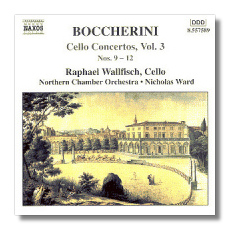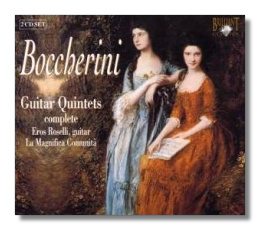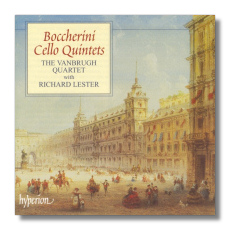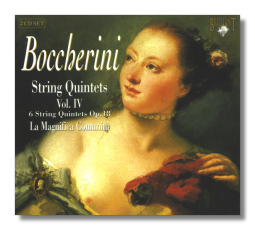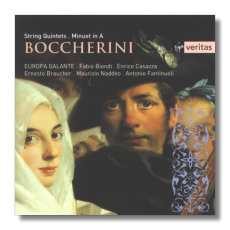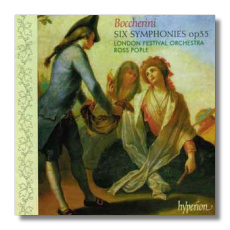
The Internet's Premier Classical Music Source
Related Links
-
Find CDs & Downloads
Amazon - UK - Germany - Canada - France - Japan
ArkivMusic - CD Universe
Find DVDs & Blu-ray
Amazon - UK - Germany - Canada - France - Japan
ArkivMusic-Video Universe
Find Scores & Sheet Music
Sheet Music Plus -
Recommended Links
Site News
Luigi Boccherini
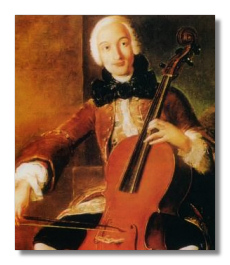
(1743 - 1805)
The sense of lyricism and of proportion in the works of the Italian composer, Luigi Boccherini is often amazing, as was his creativity and productivity. Though he was born in Lucca to a musical family, by the time he was 14 he travelled to Vienna to play in an orchestra there, and it was there that he first encountered the music of Franz Joseph Haydn, who was Boccherini's senior by nearly 19 years. He returned often to play in Italy, but by the age 25 his fame was growing and was invited to Paris to appear as a cello soloist at a Concert Spirituel. He was hailed as a great virtuoso, and his works were extremely popular and widely published. The next year he received an invitiation to become chamber composer to the court of the Infante Luis in Madrid. Boccherini stayed until 1786, the year the Infante died, and subsequently took a position with Freidrich Wilhelm II of Prussia. But by 1797 he was back in Madrid and three years later Boccherini secured the patronage of Napoleon's brother, Lucien Bonaparte, then the French ambassador to Madrid. He held this position until he died.
Boccherini admired Haydn greatly, and was strongly influenced by Haydn's style. This influence was so obvious that music lovers of the day fondly proclaimed "Boccherini is the wife of Haydn". During his long career, he wrote an impressive number of large-scale chamber works. His output includes 91 string quartets (Haydn wrote 83), an astonishing 137 quintets for various combinations of strings, as well as multitudes of trios, keyboard quintets, sextets, sonatas and other works. As a virtuoso cellist, he wrote a dozen excellent concertos for his instrument that are too little known today. Boccherini's 30 symphonies suffer in comparison with Haydn's and Mozart's, as do everyones from this period, but they are always pleasant, inviting, and sometimes surprisingly inventive. ~L.D. Lampson
Recommended Recordings
Concertos for Cello
- 12 Cello Concertos (complete) with Leo, C.P.E. Bach & Haydn/Brilliant Classics 92198
-
Julius Berger (cello), Vladislav Czarnecki/Southwest German Chamber Orchestra, Pforzheim
- 12 Cello Concertos (complete)/EBS 6058
-
Julius Berger (cello), Vladislav Czarnecki/Southwest German Chamber Orchestra, Pforzheim
- 4 Cello Concertos #1-4/Naxos 8.553571
-
Tim Hugh (cello), Anthony Halstead/Scottish Chamber Orchestra
- 4 Cello Concertos #5-8/Naxos 8.553572
-
Tim Hugh (cello), Anthony Halstead/Scottish Chamber Orchestra
- 4 Cello Concertos #9-12/Naxos 8.557589
-
Raphael Wallfisch (cello), Nicholas Ward/Northern Chamber Orchestra
- 4 Cello Concertos #4, 6-8/Teldec Das Alte Werk 903177624-2
-
Anner Bylsma (cello), Jaap Schröder/Concerto Amsterdam
- 2 Cello Concertos & 3 Cello Sonatas/Virgin 562202-2
-
Steven Isselis (cello), Maggie Cole (harpsichord), Juha Kangas/Ostrobothnian Chamber Orchestra
 Quintets for Guitar & Strings (3,
Quintets for Guitar & Strings (3,  4, 5, 6)
4, 5, 6)
- 8 Guitar Quintets (complete)/Philips 438769-2
-
Pepe Romero (guitar)/Academy Chamber Ensemble
- 8 Guitar Quintets (complete)/Brilliant 92892
-
Eros Roselli (guitar)/La Magnifica Comunità
- 3 Guitar Quintets #1-3/Harmonia Mundi HCX3957039
-
Richard Savino (guitar)/Artaria Quartet
- 3 Guitar Quintets #4-6/Harmonia Mundi HCX3957026
-
Richard Savino (guitar)/Artaria Quartet
- 2 Guitar Quintets #4 "Fandango" & #9 "La ritirada di Madrid"/Virgin Veritas 545607-2
-
Europa Galante
Quintets for Strings / Quintets for Piano & Strings
- 3 Cello Quintets Op. 42 #1, G. 348; Op. 42 #4, G. 351; Op. 11 #5 "dello L'ucceliera", G. 275/Hyperion CDA67287
-
Richard Lester (cello), The Vanbrugh Quartet
- 4 Cello Quintets Op. 28 #4, G. 310; 42 #2, G. 349; Op. 42 #3, G. 350; Op. 43 #2, G. 353/Hyperion CDA67383
-
Smithsonian Chamber Players
- 3 Cello Quintets Op. 11 #5, G. 275; Op. 25 #1, G. 295; Op. 25 #4, G. 298; Op. 25 #6, G. 300/Virgin VC545421-2
-
Europa Galante
- Cello Quintets (complete)/Brilliant Classics
-
La Magnifica Comunità
Brilliant 92503 Vol. 1 - Op. 10, G. 265-270
Amazon - UK - Germany - Canada - France - Japan - ArkivMusic - CD Universe
Brilliant 92889 Vol. 2 - Op. 11, G. 271-276
Amazon - UK - Germany - Canada - France - Japan - ArkivMusic - CD Universe
Brilliant 93076 Vol. 3 - Op. 13, G. 277-282
Amazon - UK - Germany - Canada - France - Japan - ArkivMusic - CD Universe
Brilliant 93346 Vol. 4 - Op. 18, G. 283-288
Amazon - UK - Germany - Canada - France - Japan - ArkivMusic - CD Universe
- 3 Cello Quintets Op. 39/Harmonia Mundi HMC901334
-
Ensemble 415
- 12 Piano Quintets (complete) Op. 56 & Op. 57, G. 407-418/Brilliant 92890
-
Hario Gregoletto (fortepiano), Ensemble Claviere
- 4 Piano Quintets Op. 57 #6, G. 418; Op. 57 #3, G. 415; Op. 56 #6, G. 412; Op. 56 #4, G. 410/RCA Deutsche Harmonia Mundi 5472-77448-2
-
Andreas Staier (fortepiano), Les Adieux
- 3 Piano Quintets Op. 56 #5, G. 411; Op. 56 #2, G. 408; Op. 56 #1, G. 407/Astrée E8518
-
Patrick Cohen (fortepiano), Quatuor Mosaïques
Symphonies
- 28 Symphonies/CPO 999401-2
-
Johannes Goritzki/German Chamber Academy Of Neuss
Amazon - UK - Germany - Canada - France - Japan - ArkivMusic
or Vol. 1: Op. 10 #4, G. 523; Op. 7, G. 491; G. 490 (999084-2)
Amazon - UK - Germany - Canada - France - Japan
or Vol. 2: Op.12 #1-3 G. 503-505 (999172-2)
Amazon - UK - Germany - Canada - France - Japan
or Vol. 2: Op.12 #4-6 G. 506-508 (999173-2)
Amazon - UK - Germany - Canada - France - Japan
or Vol. 4: Op. 21 #1-5, G. 493-497 (999174-2)
Amazon - UK - Germany - Canada - France - Japan
or Vol. 5: Op. 21 #6, G. 498; Op. 35 #1-3 G. 509-511 (999175-2)
Amazon - UK - Germany - Canada - France - Japan
or Vol. 6: Op. 35 #4-6, G. 512-514; Op.37 #1, G. 515 (999176-2)
Amazon - UK - Germany - Canada - France - Japan
or Vol. 7: Op. 37 #3-4, G. 517-518; Op.41, G. 519 (999177-2)
Amazon - UK - Germany - Canada - France - Japan
or Vol. 8: Op. 42, 520; Op. 45, 522; G. 500 (999178-2)
Amazon - UK - Germany - Canada - France - Japan
- 4 Symphonies, G. 490, 506, 511 & 512/Harmonia Mundi HMA1901291
-
Chiara Banchini/Ensemble 415
- 6 Symphonies Op. 35, G. 509-514/Hyperion CDA66903
-
Ross Pople/London Festival Orchestra
- 4 Symphonies Op. 37 #1,3,4 G. 515, 517, 518 & Op. 42, G. 520/Hyperion CDA66904
-
Ross Pople/London Festival Orchestra















